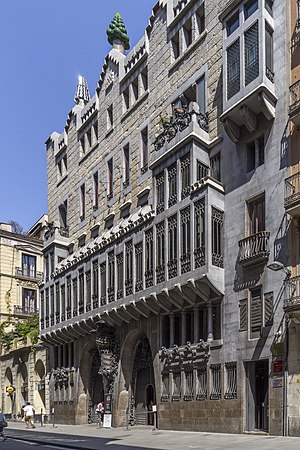Palau Güell
| Palau Güell | |
|---|---|
| Basic data | |
| Place: | Barcelona , Spain |
| Use: | City Palace |
| Construction time: | 1886 - 1890 |
| Architect : | Antoni Gaudí |
| Architectural style : | Modernism |
| Technical specifications | |
| Height: | xm |
| Width: | 22 m |
| Depth: | 18 m |
| Floors: | 6th |
| Building material: | Natural stone , marble |
Palau Güell ( Catalan for Güell Palace , Spanish : Palacio Güell ) is a city palace in the style of Modernism in the old town of Barcelona and one of the first great works by the architect Antoni Gaudí . It is located in the district of El Raval in the street Nou de la Rambla 3 to 5.
History and meaning
The town house designed by Gaudí for his patron Eusebi Güell was built between 1886 and 1890 and has an area of 18 × 22 meters. It shows for the first time the connection between decorative and structural elements, which represent a characteristic feature of Gaudí's most important later works. He used the various decorative options of the iron support elements. He also used extremely flat Byzantine brick vaults . Noticeable on the front are the two large gates (see picture), through which horse-drawn vehicles could drive in to get to the lower horse stables and storage rooms, while guests could reach the upper floors via stairs.
In this early work by Gaudí, one can clearly see his efforts to overcome historicism and to find a new language of form. While the facade is partly reminiscent of a Venetian palace (as a reminder that Güell's mother came from Italy), the interior of Palau Güell houses a rich array of handicrafts , inlays , specially designed furniture and decorations . The pieces of furniture were all designed by Gaudí himself and impress not only with their shape, but also with their style, as modernism is combined with classic elements. The elaborate vaults and ceilings are particularly impressive. The playful figures and shapes can already be found on the roof (in the form of the covers of the chimneys and ventilation towers), as we know them from Park Güell . Overall, the building leaves a dignified and majestic impression - an effect that Gaudí deliberately aimed at as a homage to his client.
At the front between the gates is a wrought iron work depicting the Catalan flag. Above it is the phoenix as a symbol of the Renaixença and as a guardian of the entrance. Both show that both the client and the architect were very patriotic. The initials E and G stand for Eusebi Güell on the gates .
The Palau Güell was added to the UNESCO World Heritage List in 1984, along with other works by Gaudí .
The Palau Güell was extensively restored between 2002 and 2011 and has been open to visitors again since then.
Trivia
A palace in the middle of the poor district
The extremely wealthy builder Eusebi Güell chose an unusual location for his city palace, because it is in the middle of the slum El Raval . Especially the Calle del Conde del Asalto (the Spanish street name at that time, today's Carrer Nou de la Rambla ) was notorious for its numerous arcades, pubs, brothels and strip clubs. But Güell's parents lived only a few meters as the crow flies in a house directly on the Ramblas and Güell made it a point to live as close as possible to them. Gaudí built an above-ground tunnel that connects the back of the Palau across the courtyard with the back of the parents' house so that family members could visit each other without any contact with the neighbors. The facade of the ground floor on the street side looks repellent and defensive due to the huge wrought-iron grilles. Gaudí designed the ground floor in such a way that you can drive through the large gates in a coach into the building and not have to get in or out in front of the house. Even so, the wealthy residents were largely spared contact with their poor neighbors.
literature
- Joan Bergós i Massó, Joan Bassegoda i Nonell, Maria A. Crippa: Gaudí. The man and the work. Hatje Cantz Verlag, Ostfildern 2000, ISBN 3-7757-0950-9 .
- Xavier Güell: Antoni Gaudí. Verlag für Architektur Artemis, Zurich 1987, ISBN 3-7608-8121-1 .
Web links
- Official website of the Palau Güell ( Memento of February 23, 2015 in the Internet Archive ) (Catalan, Spanish, English and French)
- Picture gallery of the Palau Güell of Bluffton University (in English)
- The Palau Güell on the Gaudidesigner website (in Spanish, English and French)
Individual evidence
- ↑ Area of the Palau Güell. Retrieved April 28, 2020 .
Coordinates: 41 ° 22 ′ 43.9 " N , 2 ° 10 ′ 27" E


